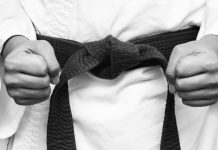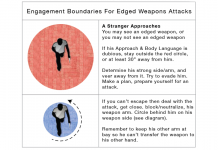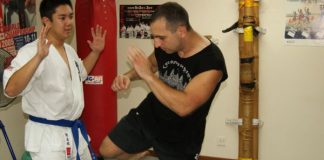 While sparring is absolutely essential for any martial artist, the real issue is how to develop a safe, effective approach.
While sparring is absolutely essential for any martial artist, the real issue is how to develop a safe, effective approach.
In my last article, Earning a Black Belt, I discussed how mastery of the martial arts means moving from simply knowing how to execute technique to learning how to apply technique against an adversary. While there are many ways to learn execution of technique, such as forms or drills, application is much more challenging. In addition to understanding distance, timing, and angle, application also requires developing the structure, balance, and feel that only comes from working against a resistant partner. In other words, application, and therefore mastery, means learning how to fight. So other than going out and actually getting into fights, which is how one Okinawan master I knew did it, the only way to learn how to fight is sparring.
But sparring can mean many different things depending on the context. The International Olympic Committee just approved no contact sparring for the 2020 Tokyo Olympics. In a recent interview, UFC fighter Donald Cerrone credited a string of victories in part to no longer sparring when preparing for a fight. And, as any owner or instructor knows, sparring is inevitably brought up by almost every prospective student or their parents, especially in this age of increased concussion awareness.
It’s in this last context that martial art schools must tread carefully. Sparring can attract students, turn them away, or cost a school its current students if it’s not managed correctly. To further complicate matters, insurance companies take any injury very seriously. A nationally franchised fitness kickboxing chain had to drop their MMA program when they lost their insurance after a student suffered a lacerated pancreas sparring his first day there. In fact, sparring can create so many problems that many schools avoid it altogether.
While sparring presents a variety of challenges, excluding it from a school’s curriculum is a tremendous disservice to students. Whether the goal is self defense, sport, or just a greater understanding of the martial arts, sparring is absolutely essential for developing the spatial awareness and timing necessary to successfully apply technique. In addition to physical conditioning, sparring also develops the mental focus necessary to remain calm when confronted with a hostile opponent. There is no substitute for the fear of getting punched in the face. As Brazilian Jiu Jitsu master Carlson Gracie said, “Punch a black belt in the face, he becomes a brown belt…” Anything short of sparring will not adequately prepare a student for the challenges presented in an actual fight.
But why is sparring essential if professional fighters are moving away from it? At this point, it’s probably a good idea to define just what sparring is and is not. Sparring is an opportunity for participants to practice different techniques in a controlled but unscripted environment. The controlled environment allows participants to make mistakes without fear of injury. The unscripted environment allows participants to develop the angle, distance, footwork, head movement, and timing necessary to successfully apply technique while under duress. The possibility of getting punched in the face is always present, but sparring partners focus on helping rather than hurting each other. There is no winner or loser! That is the difference between sparring and fighting.
Unfortunately, that difference is often lost or ignored when ego or enthusiasm override self control. When this happens, the instructor must step in and reestablish control or risk losing the entire program. I recently visited an MMA gym run by a UFC fighter. Although the instructor had specifically called for technique sparring, one of the regulars knocked out his partner when a photographer walked by. Apparently, this was the third time he had done it. If this continues, it’s only a matter of time before he seriously hurts someone, creating a liability issue for the school. At another gym I frequent, when a single boxer ignored repeated requests to control his power, several members quit after he injured each of them sparring. Not only did this cost the school a lot of money, it also hurt their reputation, especially considering that one of the members who left is the son of an official with USA Boxing.
The fact that sparring is so often confused with fighting is one reason why many MMA gyms last less than one year. When the emphasis during training is on winning rather than learning, commonly known as “throwing down”, injuries pile up quickly and newcomers are sometimes referred to as “fresh meat”. Not only does this make it difficult to keep healthy students around, but once word gets out attracting new students is almost impossible. Those that do survive get by on athletic ability and toughness and rarely develop the skills necessary to successfully compete at higher levels. This is also the type of sparring that Cerrone and other professional fighters have recognized as detrimental to their success. So whether it’s called MMA, technique, or timing sparring, true sparring is about progression rather than survival.
To avoid all of the potential pitfalls associated with sparring, it’s important to introduce it gradually. There are two general approaches, restricted attack and limited step sparring. Either approach will work in almost any given situation, but restricted attack is probably more appropriate in MMA or fighting gyms while limited step is usually used in more traditional martial arts schools. In restricted attack sparring, movement is unlimited but only certain attacks are allowed. The easiest way to begin this is jab only. Although only one type of attack is allowed, students can practice a variety of defenses. As they advance, additional techniques are added, either individually or in combinations. Not only does this approach emphasize movement rather than technique, the instructor can address a particular student’s weaknesses by choosing specific techniques or combinations.
Limited step sparring takes the concept of restricted attack even further by limiting the motion as well as the techniques allowed. It begins as a drill, with predetermined attacks and defenses. As students gain confidence, the restrictions on defense are lifted, allowing students to begin determining which techniques they are most comfortable with. Next, the restrictions on attack are lifted, with each pair of students limited to one attack and corresponding defense. This is commonly known as one step sparring. Eventually one step becomes two and then three. At first, each pair resets after every attack. Finally, that restriction is also lifted and each pair then exchanges attacks continuously. Obviously, limited step sparring is a more gradual process then restricted attack, but it allows the instructor to control the technique and pace.
If restricted attack or limited step sparring don’t provide a safe enough environment for nervous students or their parents, ground work is an alternative that doesn’t require any striking at all. The fact that most ground work, and in particular BJJ, doesn’t involve striking is one of the reasons that it is so popular. As with stand up styles, ground work can be practiced for self defense or sport, just in one particular range. While some students never practice anything but ground work, with enough experience others eventually decide to incorporate striking into their training. In taiji, the traditional progression is push hands, followed by shuai jiao (wrestling), and finally sanda (kickboxing).
Regardless of the type of sparring an instructor chooses, he or she must emphasize the goal of learning rather than winning as well as any restrictions in place that day. If this is done consistently, eventually a team environment develops in which ego is checked at the door and everyone is there to support each other’s growth as martial artists. This is the type of atmosphere that is found in almost any successful school and the most consistent way to produce true martial arts masters.







